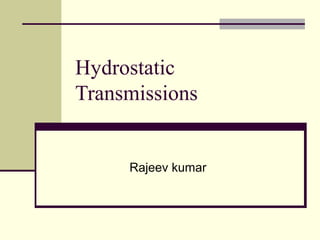Hydrostatic transmissions
- 2. Hydrostatic Operation ïŪ Hydrostatic transmissions are a pump and motor connected in a circuit together ïŪ Most are constructed using piston pumps and piston motors ïŪ Four basic configurations: ïŪ In-line ïŪ U-shaped ïŪ S-shaped ïŪ Split
- 3. In-Line Configuration ïŪ The pump is directly connected to the motor ïŪ All fluid is contained within the pump/motor combination ïŪ Usually uses a variable pump and a constant displacement motor
- 4. U-Shaped Configuration ïŪ Similar to the in-line except that the motor is connected under the pump ïŪ The motor shaft goes out the same direction and the input shaft ïŪ Used when the drive axle is under or behind the prime mover
- 5. S-Shaped Configuration ïŪ Similar to the U-shaped configuration ïŪ The motor shaft goes out behind the prime mover, but under it ïŪ Used when the drive axle is under the level of the prime mover
- 6. Split Configuration ïŪ The motor and pump and motor are not physically connected together ïŪ The motor can be located some distance from the pump and across a barrier ïŪ Contains very high pressure hose that connects the pump to the motor
- 7. Advantages of Hydrostatic Transmissions ïŪ It offers the ability to operate over a wide range of speeds without changing the prime mover speed ïŪ It can change speeds rapidly because there are no large parts which add inertia ïŪ It provide dynamic braking ïŪ There is no interruption of power to the wheels when shifting
- 8. Hydrostatic Circuits ïŪ Open circuit ïŪ All fluid comes from the tank and is pumped to the motor ïŪ When the fluid leaves the motor, it goes back to the tank ïŪ Does not require a charge pump
- 9. Hydrostatic Circuits ïŪ Closed circuit ïŪ The fluid is pumped to the motor ïŪ As the fluid leaves the motor, it is returned to the pump inlet ïŪ Requires a charge pump
- 11. Hydrostatic Transmission Operation - Pump ïŪ The cylinder is turned by the input shaft ïŪ The pistons are connected to a swash plate, which varies how much the pistons travel ïŪ The greater the angle of the swash plate, the more fluid is pumped ïŪ Reversing the angle of the swash plate causes it to pump backwards ïŪ The more fluid is pumped per revolution, the more horsepower is needed
- 13. Hydrostatic Transmission Operation - Motor ïŪ The motor accepts the fluid from the pump and turns a differential or wheel, depending on the configuration ïŪ When the pump reverses direction, the motor turns backwards, giving you reverse ïŪ Not all hydrostats are designed to pump backwards ïŪ Many motors use a shuttle valve to reverse the flow of hydraulic fluid
- 15. Hydrostatic Transmission Components ïŪ All circuit types require a relief valve to prevent overpressurizing during dynamic braking ïŪ The pump and motor have case drain lines to keep fluid that leaks internally from building pressure behind the piston ïŪ Case drains are connected to the tank ïŪ Charge pumps must provide enough fluid to replace leakage and cool the pump/motor assembly
- 17. Servo Activated Hydrostatic Transmissions ïŪ In larger hydrostats, the swash plate can be hard to move ïŪ In these systems, a small piston assembly is attached to the swash plate and activated by low pressure (300 PSI) ïŪ These servos are controlled by a small shuttle, making it easier to move the swash plate
- 19. Hydrostatic Transmission Testing ïŪ Use a flow meter hooked to the case drain line to measure to output. It should be below the charge pump volume ïŪ All hydrostatic transmissions have tight tolerances. The filters should be change at regular intervals ïŪ Many systems have a pressure sensor that shuts down the prime mover if the charge pressure falls below a certain level
- 20. Hydrostatic Transmission Testing ïŪ If the prime mover has a problem, it could fail to supply the needed power to the hydrostat ïŪ Always rule out the prime mover first when checking for insufficient power problems ïŪ Charge pressure varies, but should be between 160 to 300 PSI




















